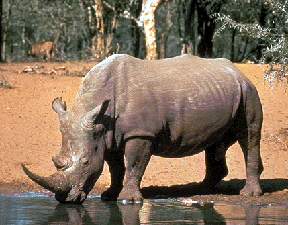And Then There Were Six
October 20, 2014
The number of northern white rhinoceroses remaining on Earth has fallen to just six with the death of Suni, a 34-year-old male that lived at the Ol Pejeta Conservancy in Kenya. Even worse, Suni was one of only two breeding males. The first northern white rhino born in captivity, Suni was found dead in his boma (fenced corral) on Friday. Officials at the reserve said Suni was not a victim of poaching for his horn and ordered a necropsy. The other breeding male as well as two females still live at Ol Pejeta. Another southern white rhino is housed at the Dvur Kralove Zoo in the Czech Republic; two of the rhinos live at the San Diego Zoo Safari Park. No northern white rhinos are known to live in the wild now.
The northern white rhino is one of two subspecies of white rhino, the largest of all rhinoceroses. The other subspecies is the southern white rhino. The white rhino stands about 5 feet 8 inches (1.7 meters) tall. In some cases, it may be over 6 feet (1.8 meters) tall and 15 feet (4.6 meters) long. It weighs about 31/2 tons (3.2 metric tons).

The white rhinoceros is the largest kind of rhinoceros. There are two subspecies of white rhinoceros, the northern white rhino and the southern white rhino. (Clem Haagner, Bruce Coleman Inc.)
Suni, who was born at the Dvur Kralove Zoo, and three other rhinos were moved to the Ol Pejeta Conservancy in 2009 as part of a program called “Last Chance to Survive.” Officials had hoped that the natural conditions in Kenya would improve the rhinos’ chances of breeding and so save the subspecies from extinction. Suni had mated twice with one of the females, but the two did not produce offspring.
Thousands of northern white rhinos once roamed parts of East and Central Africa south of the Sahara. The animal’s situation grew dire in the 1970′s and 1980′s, as poaching for rhino horn cut the wild population, from about 500 to only 15. Many Asian people believe the powdered horn of the rhinoceros has healing qualities and can be used to cure lung and chest illnesses. Some people believe the horn has magical powers. Asian people also use the skin, blood, and urine of rhinoceroses to cure illnesses. Rhino horn now sells for more than gold or platinum. In a statement on Suni’s death, Ol Pejeta officials said, “the species now stands at the brink of complete extinction, a sorry testament to the greed of the human race.”
Additional World Book articles:


